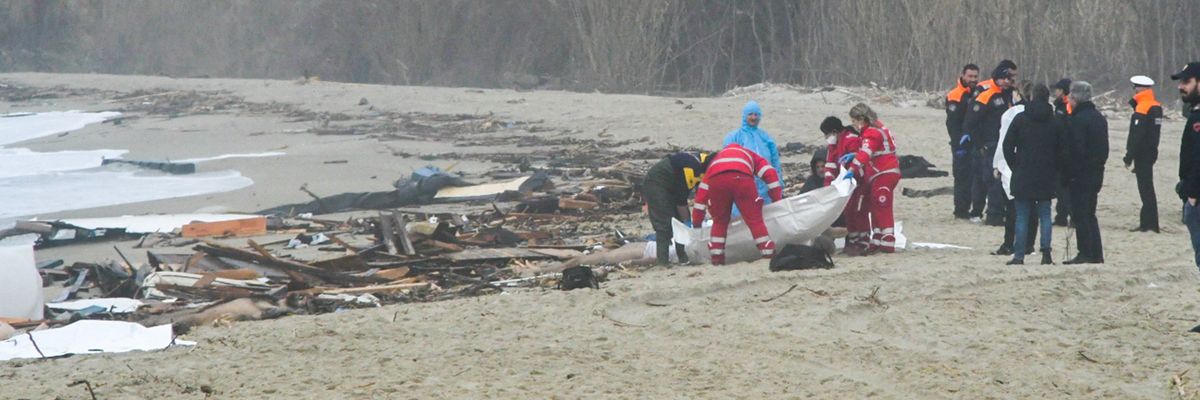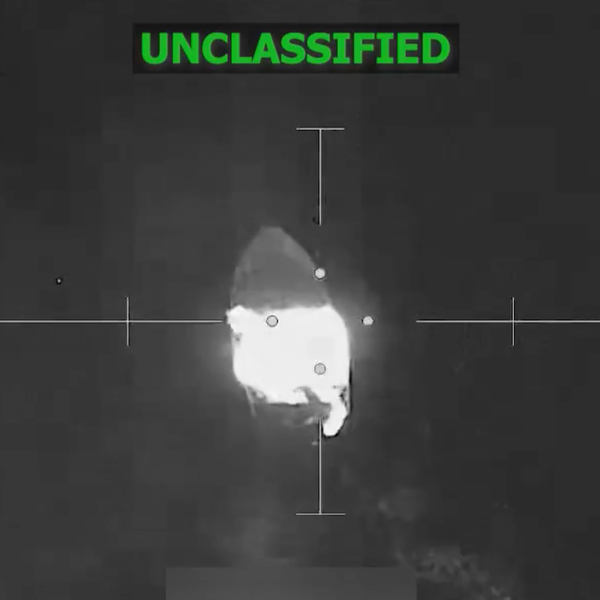
This photo obtained from Italian news agency Ansa, taken on February 26, 2023 shows rescuers handling a body bag at the site of a shipwreck in Steccato di Cutro, south of Crotone, after a migrants' boat sank off Italy's southern Calabria region.
Sea of Death and Our Unforgiveable Cruelty Towards Migrants
"The answer to the Crotone disaster is the expansion of rescue capacities at sea and not their confiscation. The answer is safe and legal entry routes and not Fortress Europe.”
The bodies of drowned migrants are still washing up on the beaches of Crotone, Italy on the Mediterranean Sea. Their wooden boat crashed on the rocks just offshore from this Calabrian resort town, turning the beach, said one local, “into a graveyard.” The death toll reached 67 on Wednesday, with 80 survivors. It is assumed that many more died, as at least 200 people were aboard the boat when it departed Izmir, Turkey, a few days earlier.
“I have been treating migrants for 30 years and have never seen anything like this,” Orlando Amodeo, a local doctor, told The Guardian. “These people traveled 1,078 kilometers by sea only to die three meters from the shore.”
The Mediterranean Sea itself has become a massive graveyard in recent years. The UN’s International Organization for Migration (IOM) estimates that at least 26,000 migrants have perished while crossing to Europe, mostly from Turkey and Libya, fleeing Afghanistan, Syria, and drought-stricken and war-torn African nations. Many more migrants have died uncounted, as clandestine voyages on makeshift boats, overcrowded by human traffickers out to maximize profit, too often disappear at sea without a trace.
“There is a lot more media attention in this case because the tragedy happened so close to Italy,” Caroline Willemen, deputy head of search and rescue with Médecins Sans Frontières, or Doctors Without Borders, said of the Crotone shipwreck on the Democracy Now! news hour. “But this is something that happens on a quite, unfortunately, regular basis, also very often closer, for example, to the Libyan coast, to people leaving Libyan shores. Very often that news will not even reach Western media.”
Over seven million Ukrainians fleeing the Russian invasion have rightly been welcomed in Europe. Teymoori Mohammad lost a relative in the Crotone disaster. Speaking to the press there, he lamented the lack of equal treatment for non-white refugees:
“Because they have their black hair or they don’t have green or blue eyes, they didn’t rescue these people…their human right. Because they have the black eye or the black hair, they weren’t human.”
MSF has been operating search and rescue vessels in the Mediterranean since 2015, plying dangerous waters to rescue thousands of migrants who might otherwise have died, while also dodging an increasing array of regulations and restrictions imposed by European countries intent on blocking migration. MSF’s latest ship, the Geo Barents, was refitted and launched in June, 2021. It is currently impounded in a Sicilian port, victim of Italy’s new crackdown on humanitarian search and rescue operations, launched by the far-right government of Prime Minister Giorgia Meloni.
“This new legislation that has come out targets only NGOs doing search-and-rescue work,” Willemen explained. “Keep in mind that the vast majority of people who arrive in Italy, either they manage to arrive autonomously or they are rescued by the Italian Coast Guard, but the legislation targets only NGOs, which says quite a lot.”
Médecins Sans Frontières is not the only humanitarian organization involved in migrant rescue that is being hounded by various European governments. Sea-Watch, RESQSHIP and other German-based groups are condemning Germany’s new ship safety ordinance that seems designed specifically to hamper civilian migrant rescue operations.
In 2015, a youth-driven project led to the acquisition and conversion of a small fishing vessel christened Iuventa. The ship operated in the central Mediterranean, considered the most dangerous route to Europe, helping save 14,000 migrants from 2015 until it was seized by Italian authorities in 2017. Now, more than five years later, several crew members are being tried in Italy, along with activists from MSF and Save the Children, accused of “aiding and abetting unauthorized immigration.”
Sascha Girke, one of the Iuventa crew members made a statement in court on Wednesday:
“I would like to begin this statement today, in this courtroom by commemorating those who lost their lives off the coast of Crotone…while we were sitting in this courtroom on Saturday, they started to fight for their lives. In a terrible and unambiguous way, the deaths of these people remind us of what is actually being on trial here: the Crotone shipwreck is inseparable from this trial…It wasn’t the bad sea weather – it was the denial of help where it was possible. The answer to the Crotone disaster is the expansion of rescue capacities at sea and not their confiscation. The answer is safe and legal entry routes and not Fortress Europe.”
Six years ago, Dr. Orlando Amodeo posted a video showing body bags of drowned migrants being lowered to a dock, off of one of MSF’s rescue ships. He called the video “From Mare Nostrum to Mare Mortuum,” invoking the ancient Roman name for the Mediterranean, Mare Nostrum, “Our Sea,” and naming what it has become, Mare Mortuum, the Sea of Death.
An Urgent Message From Our Co-Founder
Dear Common Dreams reader, The U.S. is on a fast track to authoritarianism like nothing I've ever seen. Meanwhile, corporate news outlets are utterly capitulating to Trump, twisting their coverage to avoid drawing his ire while lining up to stuff cash in his pockets. That's why I believe that Common Dreams is doing the best and most consequential reporting that we've ever done. Our small but mighty team is a progressive reporting powerhouse, covering the news every day that the corporate media never will. Our mission has always been simple: To inform. To inspire. And to ignite change for the common good. Now here's the key piece that I want all our readers to understand: None of this would be possible without your financial support. That's not just some fundraising cliche. It's the absolute and literal truth. We don't accept corporate advertising and never will. We don't have a paywall because we don't think people should be blocked from critical news based on their ability to pay. Everything we do is funded by the donations of readers like you. Will you donate now to help power the nonprofit, independent reporting of Common Dreams? Thank you for being a vital member of our community. Together, we can keep independent journalism alive when it’s needed most. - Craig Brown, Co-founder |
The bodies of drowned migrants are still washing up on the beaches of Crotone, Italy on the Mediterranean Sea. Their wooden boat crashed on the rocks just offshore from this Calabrian resort town, turning the beach, said one local, “into a graveyard.” The death toll reached 67 on Wednesday, with 80 survivors. It is assumed that many more died, as at least 200 people were aboard the boat when it departed Izmir, Turkey, a few days earlier.
“I have been treating migrants for 30 years and have never seen anything like this,” Orlando Amodeo, a local doctor, told The Guardian. “These people traveled 1,078 kilometers by sea only to die three meters from the shore.”
The Mediterranean Sea itself has become a massive graveyard in recent years. The UN’s International Organization for Migration (IOM) estimates that at least 26,000 migrants have perished while crossing to Europe, mostly from Turkey and Libya, fleeing Afghanistan, Syria, and drought-stricken and war-torn African nations. Many more migrants have died uncounted, as clandestine voyages on makeshift boats, overcrowded by human traffickers out to maximize profit, too often disappear at sea without a trace.
“There is a lot more media attention in this case because the tragedy happened so close to Italy,” Caroline Willemen, deputy head of search and rescue with Médecins Sans Frontières, or Doctors Without Borders, said of the Crotone shipwreck on the Democracy Now! news hour. “But this is something that happens on a quite, unfortunately, regular basis, also very often closer, for example, to the Libyan coast, to people leaving Libyan shores. Very often that news will not even reach Western media.”
Over seven million Ukrainians fleeing the Russian invasion have rightly been welcomed in Europe. Teymoori Mohammad lost a relative in the Crotone disaster. Speaking to the press there, he lamented the lack of equal treatment for non-white refugees:
“Because they have their black hair or they don’t have green or blue eyes, they didn’t rescue these people…their human right. Because they have the black eye or the black hair, they weren’t human.”
MSF has been operating search and rescue vessels in the Mediterranean since 2015, plying dangerous waters to rescue thousands of migrants who might otherwise have died, while also dodging an increasing array of regulations and restrictions imposed by European countries intent on blocking migration. MSF’s latest ship, the Geo Barents, was refitted and launched in June, 2021. It is currently impounded in a Sicilian port, victim of Italy’s new crackdown on humanitarian search and rescue operations, launched by the far-right government of Prime Minister Giorgia Meloni.
“This new legislation that has come out targets only NGOs doing search-and-rescue work,” Willemen explained. “Keep in mind that the vast majority of people who arrive in Italy, either they manage to arrive autonomously or they are rescued by the Italian Coast Guard, but the legislation targets only NGOs, which says quite a lot.”
Médecins Sans Frontières is not the only humanitarian organization involved in migrant rescue that is being hounded by various European governments. Sea-Watch, RESQSHIP and other German-based groups are condemning Germany’s new ship safety ordinance that seems designed specifically to hamper civilian migrant rescue operations.
In 2015, a youth-driven project led to the acquisition and conversion of a small fishing vessel christened Iuventa. The ship operated in the central Mediterranean, considered the most dangerous route to Europe, helping save 14,000 migrants from 2015 until it was seized by Italian authorities in 2017. Now, more than five years later, several crew members are being tried in Italy, along with activists from MSF and Save the Children, accused of “aiding and abetting unauthorized immigration.”
Sascha Girke, one of the Iuventa crew members made a statement in court on Wednesday:
“I would like to begin this statement today, in this courtroom by commemorating those who lost their lives off the coast of Crotone…while we were sitting in this courtroom on Saturday, they started to fight for their lives. In a terrible and unambiguous way, the deaths of these people remind us of what is actually being on trial here: the Crotone shipwreck is inseparable from this trial…It wasn’t the bad sea weather – it was the denial of help where it was possible. The answer to the Crotone disaster is the expansion of rescue capacities at sea and not their confiscation. The answer is safe and legal entry routes and not Fortress Europe.”
Six years ago, Dr. Orlando Amodeo posted a video showing body bags of drowned migrants being lowered to a dock, off of one of MSF’s rescue ships. He called the video “From Mare Nostrum to Mare Mortuum,” invoking the ancient Roman name for the Mediterranean, Mare Nostrum, “Our Sea,” and naming what it has become, Mare Mortuum, the Sea of Death.
- Migrant Rescue Crackdown by Italy's Far-Right Cabinet Slammed as 'Call to Let People Drown' ›
- At Least 58 Dead After Migrant Boat Breaks Apart Near Italian Coast ›
The bodies of drowned migrants are still washing up on the beaches of Crotone, Italy on the Mediterranean Sea. Their wooden boat crashed on the rocks just offshore from this Calabrian resort town, turning the beach, said one local, “into a graveyard.” The death toll reached 67 on Wednesday, with 80 survivors. It is assumed that many more died, as at least 200 people were aboard the boat when it departed Izmir, Turkey, a few days earlier.
“I have been treating migrants for 30 years and have never seen anything like this,” Orlando Amodeo, a local doctor, told The Guardian. “These people traveled 1,078 kilometers by sea only to die three meters from the shore.”
The Mediterranean Sea itself has become a massive graveyard in recent years. The UN’s International Organization for Migration (IOM) estimates that at least 26,000 migrants have perished while crossing to Europe, mostly from Turkey and Libya, fleeing Afghanistan, Syria, and drought-stricken and war-torn African nations. Many more migrants have died uncounted, as clandestine voyages on makeshift boats, overcrowded by human traffickers out to maximize profit, too often disappear at sea without a trace.
“There is a lot more media attention in this case because the tragedy happened so close to Italy,” Caroline Willemen, deputy head of search and rescue with Médecins Sans Frontières, or Doctors Without Borders, said of the Crotone shipwreck on the Democracy Now! news hour. “But this is something that happens on a quite, unfortunately, regular basis, also very often closer, for example, to the Libyan coast, to people leaving Libyan shores. Very often that news will not even reach Western media.”
Over seven million Ukrainians fleeing the Russian invasion have rightly been welcomed in Europe. Teymoori Mohammad lost a relative in the Crotone disaster. Speaking to the press there, he lamented the lack of equal treatment for non-white refugees:
“Because they have their black hair or they don’t have green or blue eyes, they didn’t rescue these people…their human right. Because they have the black eye or the black hair, they weren’t human.”
MSF has been operating search and rescue vessels in the Mediterranean since 2015, plying dangerous waters to rescue thousands of migrants who might otherwise have died, while also dodging an increasing array of regulations and restrictions imposed by European countries intent on blocking migration. MSF’s latest ship, the Geo Barents, was refitted and launched in June, 2021. It is currently impounded in a Sicilian port, victim of Italy’s new crackdown on humanitarian search and rescue operations, launched by the far-right government of Prime Minister Giorgia Meloni.
“This new legislation that has come out targets only NGOs doing search-and-rescue work,” Willemen explained. “Keep in mind that the vast majority of people who arrive in Italy, either they manage to arrive autonomously or they are rescued by the Italian Coast Guard, but the legislation targets only NGOs, which says quite a lot.”
Médecins Sans Frontières is not the only humanitarian organization involved in migrant rescue that is being hounded by various European governments. Sea-Watch, RESQSHIP and other German-based groups are condemning Germany’s new ship safety ordinance that seems designed specifically to hamper civilian migrant rescue operations.
In 2015, a youth-driven project led to the acquisition and conversion of a small fishing vessel christened Iuventa. The ship operated in the central Mediterranean, considered the most dangerous route to Europe, helping save 14,000 migrants from 2015 until it was seized by Italian authorities in 2017. Now, more than five years later, several crew members are being tried in Italy, along with activists from MSF and Save the Children, accused of “aiding and abetting unauthorized immigration.”
Sascha Girke, one of the Iuventa crew members made a statement in court on Wednesday:
“I would like to begin this statement today, in this courtroom by commemorating those who lost their lives off the coast of Crotone…while we were sitting in this courtroom on Saturday, they started to fight for their lives. In a terrible and unambiguous way, the deaths of these people remind us of what is actually being on trial here: the Crotone shipwreck is inseparable from this trial…It wasn’t the bad sea weather – it was the denial of help where it was possible. The answer to the Crotone disaster is the expansion of rescue capacities at sea and not their confiscation. The answer is safe and legal entry routes and not Fortress Europe.”
Six years ago, Dr. Orlando Amodeo posted a video showing body bags of drowned migrants being lowered to a dock, off of one of MSF’s rescue ships. He called the video “From Mare Nostrum to Mare Mortuum,” invoking the ancient Roman name for the Mediterranean, Mare Nostrum, “Our Sea,” and naming what it has become, Mare Mortuum, the Sea of Death.
- Migrant Rescue Crackdown by Italy's Far-Right Cabinet Slammed as 'Call to Let People Drown' ›
- At Least 58 Dead After Migrant Boat Breaks Apart Near Italian Coast ›

